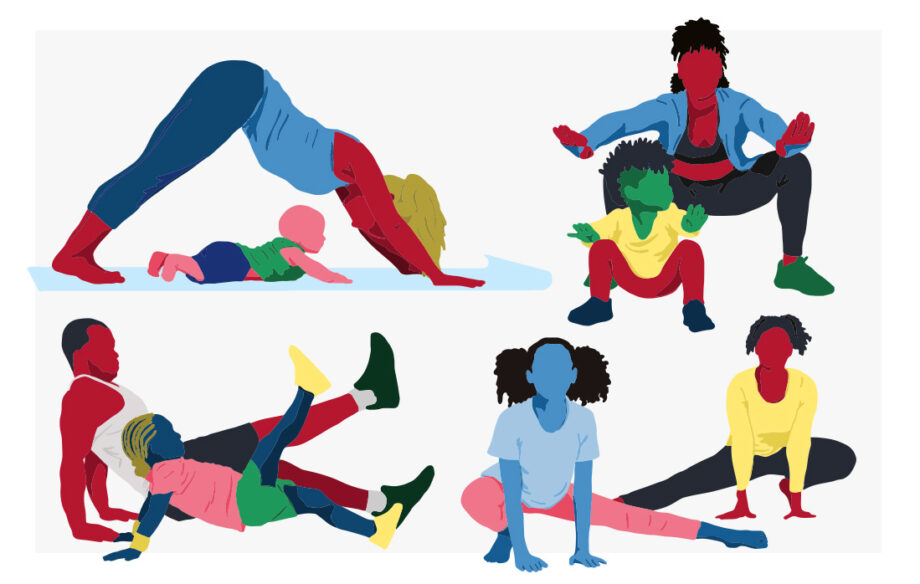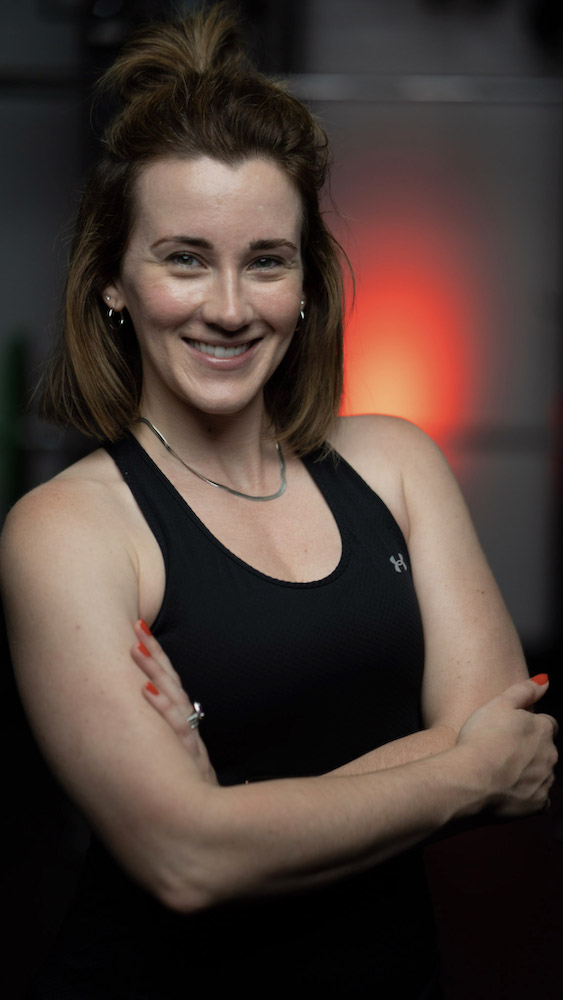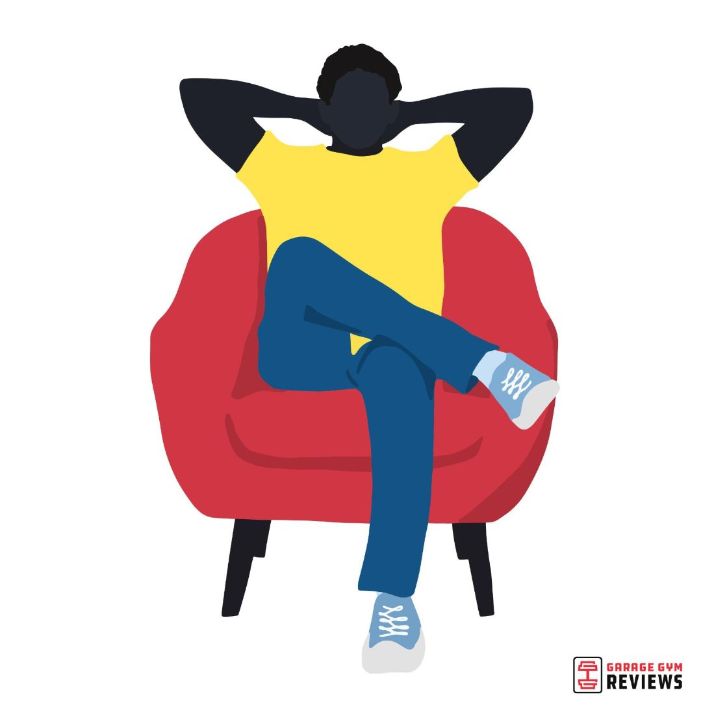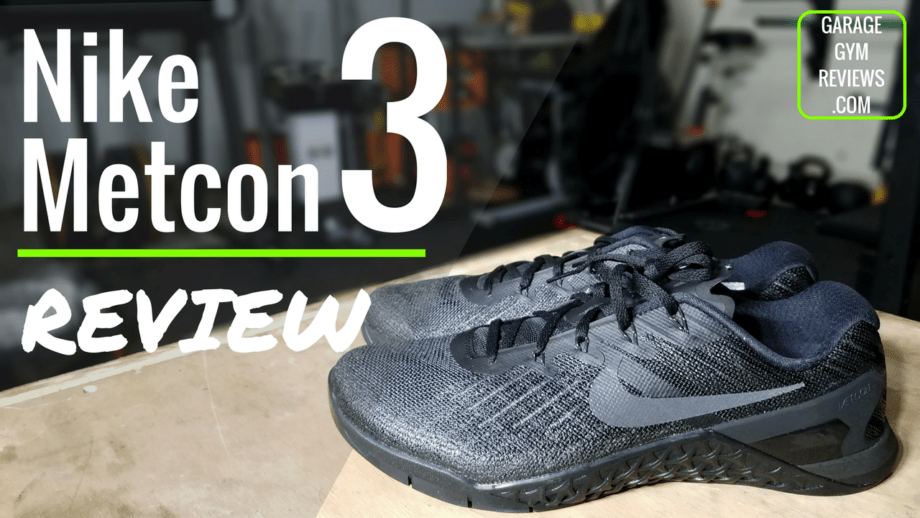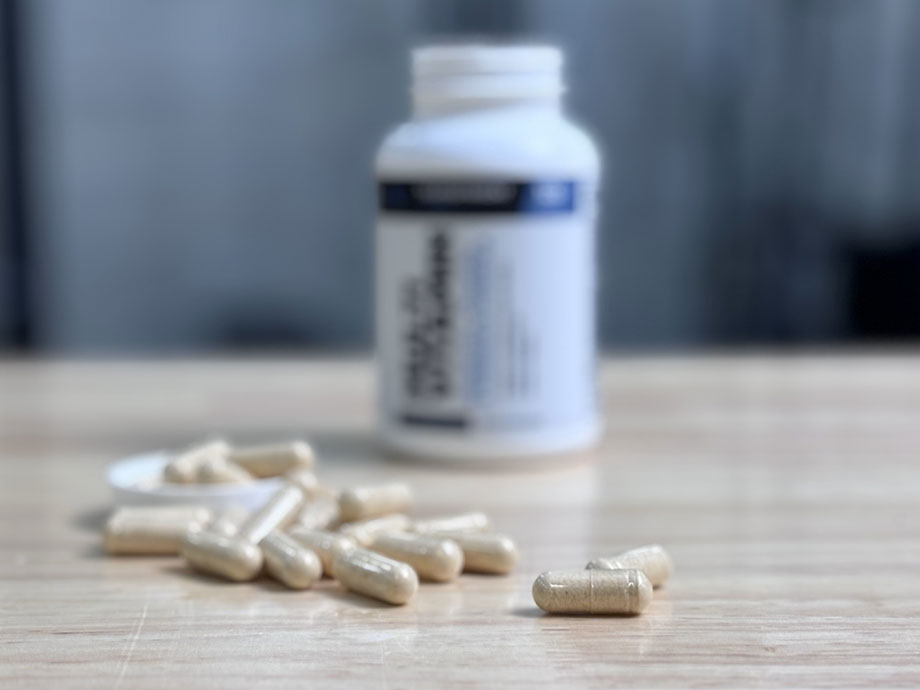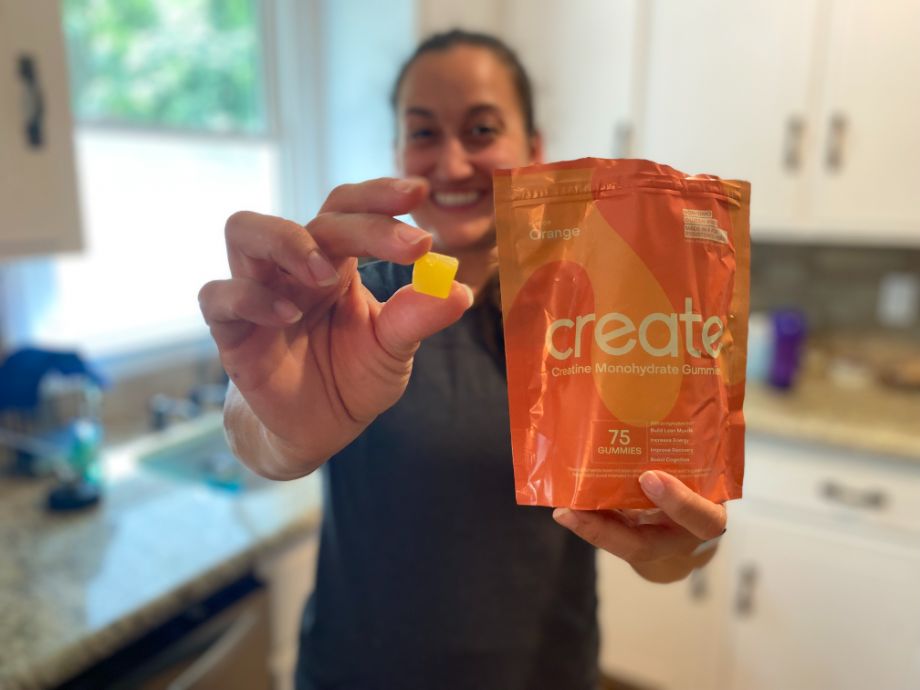Expert advice, plus three workouts to try for toddlers to teens
Being a parent or caregiver is tough work, and fitting in time for your own fitness routine might seem near impossible between cooking meals, doing laundry, taking care of your kids, and working a job of your own.
Figuring out how to get your whole family active together could not only work best for your hectic schedule, but provide some great benefits for your kiddos, too.
Before I was a mom of two, I was a certified personal trainer, as well as a runner, a bikini competitor, and even a triathlete. And after my first daughter came along—almost four years ago now—I became passionate about prenatal and postnatal fitness, teaching stroller bootcamp classes and working with expecting moms as clients.
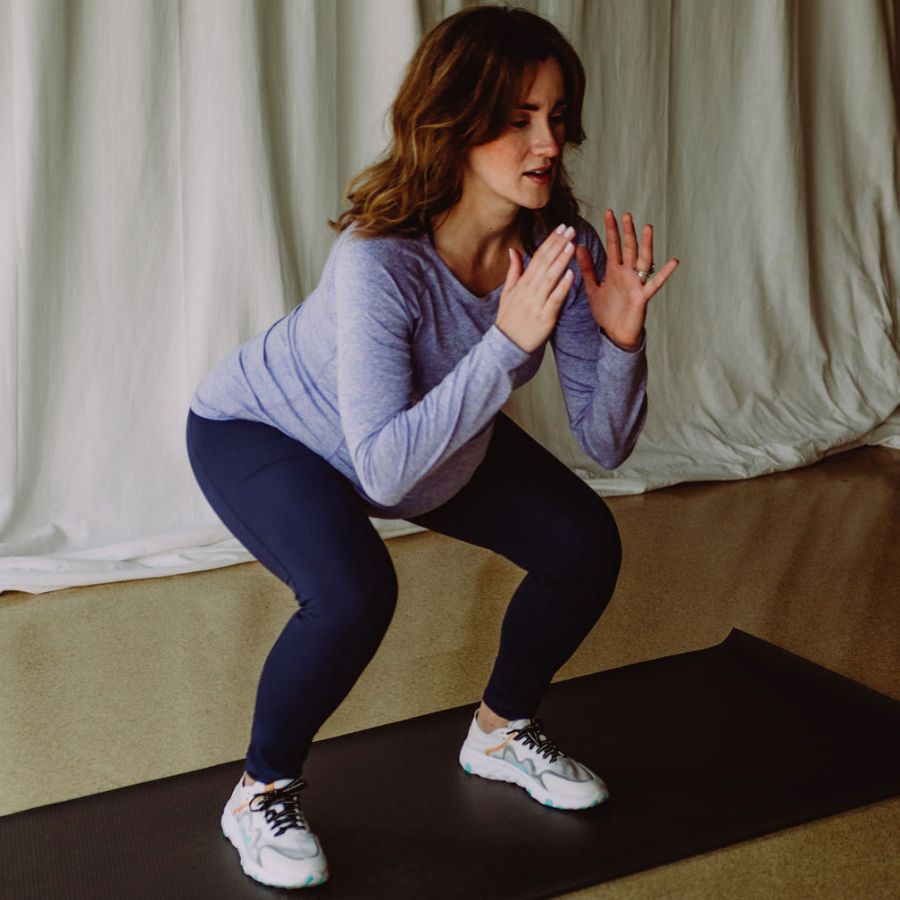
Family fitness is something that I, as well as the other parents on the GGR team, strive to live everyday. I love incorporating my girls into my fitness routine, or, if nothing else, setting an example for them to follow.
Read on for tips and sample workouts to get kids of all ages exercising alongside you.
Medical disclaimer: This article is intended for educational and informational purposes only. It is not a substitute for health or medical advice. For medical advice, contact an appropriate healthcare provider.
How To Get Kids More Involved in Exercise
Getting your kids up and moving with you requires a multifaceted approach, but it doesn’t have to be complicated.
First, lead by example. If your kids see you being active—going for a run, lifting weights, doing yoga—the more likely it will become second nature for them.
Take it from Cooper Mitchell, director of GGR, who started his garage gym, in part, so that his kids would see his commitment.
“My motto is if I want them to do something, I should be doing it and eventually they’ll copy me,” he says. “So, without prompting, typically my kids will try and do what I’m doing during a workout, whether that’s planks or squats. Just having my kids see me making fitness a part of my life has a bigger impact than I think most of us realize.”
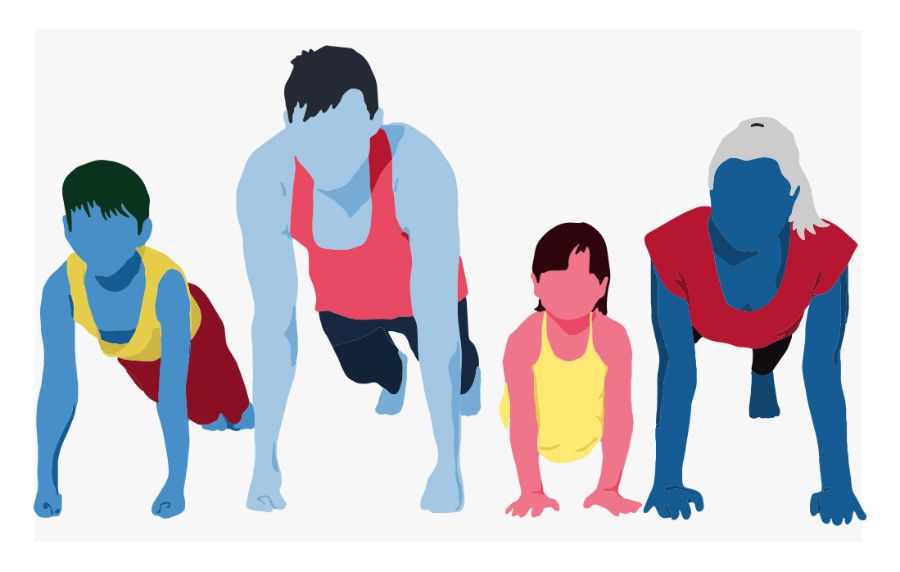
Also, being active together as a family is something that can make a huge impact in how kids view fitness.
“Parents who work out with their kids have the opportunity not only to bond, but to set an excellent example for a lifetime of healthy habits,” explains Sarah Cwiak, doctor of physical therapy and board-certified clinical specialist in pediatric physical therapy.
“Studies have shown that kids who are active with their parent or caregiver are far more likely to engage in physical activity on their own. Not only that, but the experience of working out with a trusted adult is likely to result in that child learning how to recognize their emotions and opening up to expressing themselves, a critical skill in long-term mental wellbeing that lasts into adulthood.”
Lastly, think about slating family fitness into your weekly schedule so your kids will anticipate it. For example, maybe every Friday after school you go for a bike ride to the park, or every night before bed you do a quick 5-minute yoga routine. Kids thrive on schedules, and exercise doesn’t have to be time-consuming or complicated—adding short moments of activity into your days can make a big difference over time.
5 tips for Exercising With Your Kids
Are you ready to get your kids up and moving with you, but you’re unsure of where to start? We’ve got you covered.
Tip 1: Start Them Young
Even newborns can reap benefits from exercising with mom and dad. Taking your little one out on a walk in the stroller or a carrier is one of the most basic ways to introduce them to exercise, and can set the foundation for an active, healthy life.
Babies can also watch while you do a resistance training or HIIT-style workout. Count out loud and explain what you’re doing, as listening to mom or dad’s voice narrate what’s happening is great for their development.
I taught stroller fitness classes with my daughter in tow starting when she was 3 months old, and by 2 years old, she could squat and lunge along with me during class (which was simply the cutest, btw!).
Tip 2: Focus on The Basics First
Especially for the younger ones—and even older kids who are new to exercise—creating a foundation with fundamental movements is the way to go. Mastering exercises like squats, planks, lunges, and push-ups will help them build strength, balance, and coordination and set them up for success down the line.
Tip 3: Balance Cardio and Strength
A well-rounded exercise routine combines cardiovascular activity with strength training. Walking, running, jumping jacks, or even a dance party can count as cardio, and strength training can be as simple as some bodyweight movements.
Tip 4: Make it Fun
GGR’s Head of Content Kate Meier has two kids who are 9 and 11 years old, but they’ve been lifting weights since they were about 5. Kate also actively coaches youth sports and weightlifting. Her no.1 rule?
“Keep it fun!” she says. “You want your kids to enjoy exercise, or else they will view it as a chore, or have a negative experience and form a bad relationship with fitness.”
For example, in teaching kids under 10, she incorporates fun warmups and activities like “be an animal” where they’ll do bear crawls, crab walks, frog jumps, donkey kicks, and bunny hops.
Tip 5: Keep Safety in Mind
Safety during exercise should be a concern no matter your age, but it’s an especially pertinent topic for kids.
First, ensure that the workout environment is free from obstacles and that children know how to handle equipment properly. Or, if they’re too young, keep heavy dumbbells and things of that nature out of reach.
Also, older kids can definitely add weight to exercises—research has debunked the myths that weight lifting can stunt growth or lead to injuries in adolescents. But, if your kids will be lifting weights, keep the load light and always monitor form.
“Yes, kids can go heavy (eventually), but if they’re just starting out, it’s most important that they learn proper form on movements,” Kate says. “Start with the air squat, perfect it, and then hand over light dumbbells or barbells.”
3 Easy Workouts To Try With Your Kids
Whether you have a toddler, a school-aged kid, or a teen at home, we’ve got a workout for you.
Workout For Toddlers
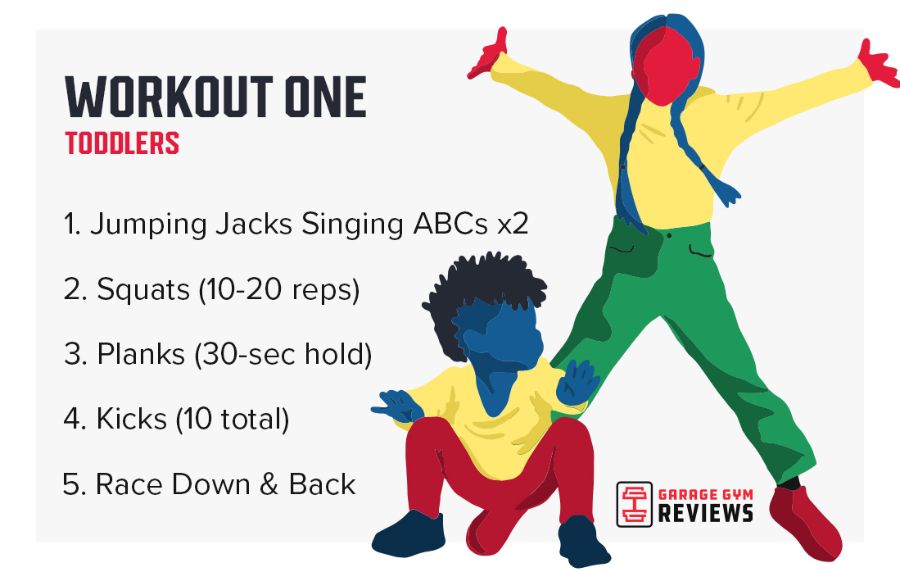
Any parent of a kid ages 1 to 3 years old knows two things: They won’t keep still, and they have a short attention span.
Workout focus: To get them moving
Complete this circuit two to three times—or as many as your kiddos will entertain.
- Jumping jacks while singing the ABCs (2x)
- Squat (10-20 reps)
- Plank (30-second hold)
- Kicks (10 total)
- Run down and back
Tip: Count your reps out loud, and have your kiddos join in.
Tip: If your toddler gets fussy, and if you’re able, try holding them for the squats or letting them crawl underneath you during the plank.
Tip: For the down and back run, use a hallway at home, the length of the backyard, or even run in place for 10 to 15 seconds—you can make it work in your space!
Workout For School-Aged Kids
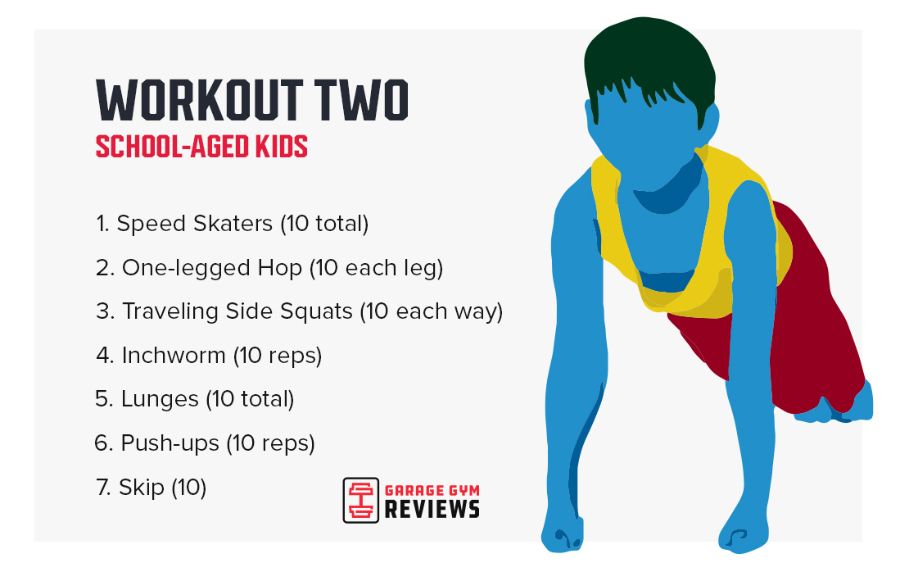
When kids are a bit older, ages 5-12, we still want to encourage any type of movement, but now, you can start to challenge their physical abilities with exercises that promote bodily awareness.
Workout focus: Balance, coordination, speed, agility, and strength
Complete this circuit two to three times through.
- Speed skaters (10 total)
- One-legged hop (10 on each leg)
- Traveling side squats (10 each way)
- Inchworm (10 reps)
- Lunge (10 total)
- Push-up (10 reps)
- Skip (10)
Tip: The magic number for this workout is 10…everything we do, we do it 10 times!
Tip: If any of the moves aren’t clicking, just encourage your kiddo to keep moving.
Workout For Teens
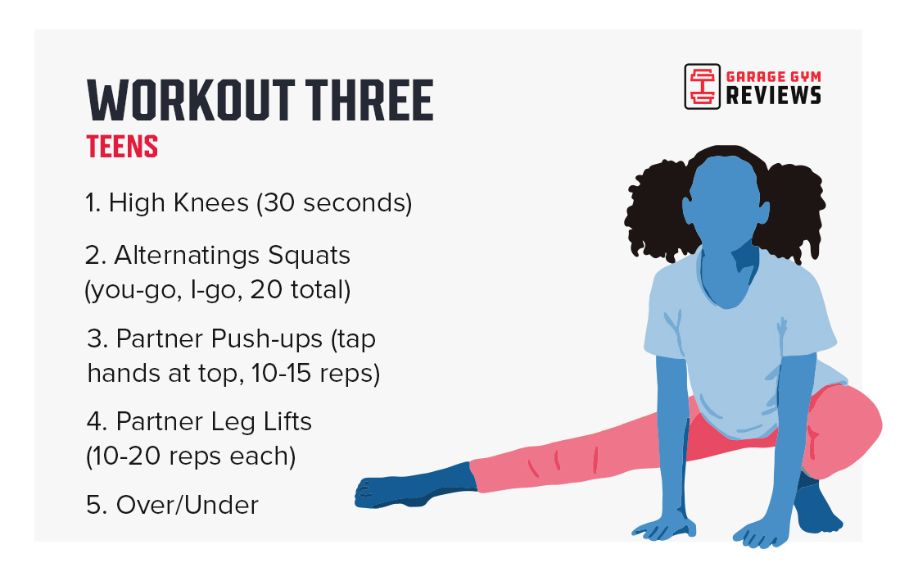
Kids ages 13 through 17 should have a good grasp on basic exercises and their own body mechanics, so now, it’s time to crank up the intensity. Encourage your teen to add resistance to any of the moves below, via a pair of adjustable dumbbells or even resistance bands, if bodyweight isn’t challenging enough.
Workout focus: Full-body partner workout
Complete this circuit 2 to 3 times through, working with your teen as a partner.
- High knees (30 seconds)
- You go, I go alternating squats (20 total)
- Partner push-ups 10-15 reps)
- Partner leg lift (10-20 reps for each person)
- Over/unders (5 reps for each person)
Tip: During the partner push-ups, perform them simultaneously and give each other a high five at the top of each rep.If strict push-ups aren’t quite there, perform this move off of an elevated surface like a bench or stairs.
Tip: Here’s how to complete over/unders: partner A holds plank, partner B does lateral jump over partner A, partner A comes up to a pike plank, partner B crawls underneath partner A.
Why Is Exercise Important For Kids?
We often think of getting active as a way to promote physical health, and there are certainly plenty of benefits in this realm for kids, including:
- Better blood pressure
- Body weight regulation
- Stronger bones
- Muscle growth and strength
- Maintenance of normal blood sugar levels
There are mental and emotional benefits of regular physical activity for kids, too. And as Cwiak explains, with the mental wellbeing of kids of all ages in the U.S. on the decline since before the pandemic with no signs of slowing down, getting (and keeping) our kids physically active is more important now than ever.
Mental health benefits of exercise for kids, according to Cwiak, include:
- A boost in their moods, and their immune systems. Spending more time in good health and good spirits arms kids of all ages with a protective quality for the days when they do face disappointments (a poor grade, a disagreement with a friend, struggling with their body image or self-esteem, etc.)
- Improved memory and ability to concentrate
- A decrease in stress hormones while releasing endorphins that result in reduced anxiety and depression
- The ability to help them think through their problems and worries to more easily come to solutions or let things go rather than holding onto negative thoughts and emotions
FAQs About Family Fitness
How can I exercise with my toddler at home?
We know that exercising with a toddler at home is not easy, so give yourself credit for even attempting it! You have a few options: Try incorporating them into your workout, having them mirror what you’re doing. Or, set them up with some snacks and a few toys while you get in a quick 15- or 20-minute workout in the same room. Or, if all else fails, plan for a short workout during nap or rest time. Just remember that something is better than nothing as far as exercise is concerned, and this stage doesn’t last forever.
Does working out affect your children?
Yes! Working out has plenty of positive effects on children, including improved blood pressure, weight regulation, strong bones and muscles, plus better moods, decreases in stress, and better ability to concentrate. If you work out in their presence, that has a positive impact as well.
How do working parents fit in exercise?
Being strategic with the time you have available is key. You may only have 10 or 15 minutes to devote to exercise daily, in between your job, and taking care of your kids, your house, and other responsibilities. The key is to make the most of the time you do have, and to stay consistent. Something is always better than nothing, so go for that quick walk or run, do that 10-minute yoga flow or 15-minute bootcamp on YouTube, and keep doing it day after day. Making it a habit is key, and hopefully sooner rather than later, you’ll have more time to devote to exercise in your daily life.


